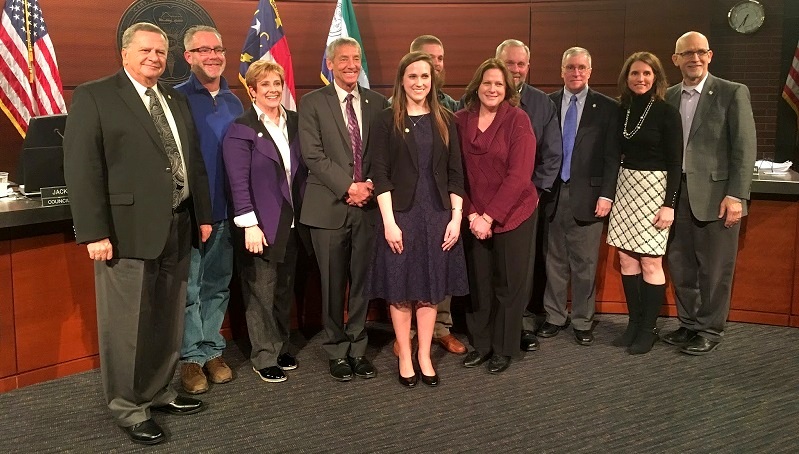Don’s Blog: Worksession, Council Meeting & Town Clerk
Cary, NC — On February 23, 2016, the council held a worksession to discuss a number of items – half of which we never even got to, as time ran out. It amazes me how things that seem so simple become so complex and vice-versa.
Worksession
On the agenda was a review of quasi-judicial proceedings, consideration and discussion on a number of Imagine Cary chapters and the impact of House Bill 44 on development adjacent to stream buffers. House Bill 44 is entitled:
An act to reform various provisions of the law related to local government
It was approved and became the law on September 23, 2015.
This Law Sucks
Some of the “reforms” in this law include:
143-214-23A. Limitations on local government riparian buffer requirements.
(e) Cities and counties shall not treat the land within a riparian buffer area as if the land is the property of the State or any of its subdivisions unless the land or an interest therein has been acquired by the State or its subdivisions by a conveyance or by eminent domain. Land within a riparian buffer area in which neither the State nor its subdivisions holds any property interest may be used by the property owner to satisfy any other development-related regulatory requirements based on property size, including, but not limited to, residential density and nonresidential intensity calculations and yields, tree conservation purposes, open space or conservation area requirements, setbacks, perimeter buffers, and lot area requirements.
(f) When riparian buffer requirements are included within a lot, cities and counties shall require that riparian buffer area be shown on the recorded plat. Nothing in this subsection shall be construed to require that the riparian buffer area be surveyed. When riparian buffer requirements are placed outside of lots in portions of a subdivision that are designed as common areas or open space and neither the State nor its subdivisions holds any property interest in that riparian buffer area, the local governments shall attribute to each lot abutting the riparian buffer area a proportionate share based on the area of all lots abutting the riparian buffer area for purposes of development-related regulatory requirements based on property size, including, but not limited to, residential density and nonresidential density calculations and nonresidential intensity calculations and yields, tree conservation purposes, open space or conservation area requirements, setbacks, perimeter buffers, and lot area requirements.
What Does That Mean?
What all of that gobbledegook means is that, for individual lots platted adjacent to a stream buffer, the area within the stream buffer must be treated as part of the lot for the purpose of determining compliance with lot size, setback and perimeter buffer requirements, and there isn’t anything Cary or any other municipality in North Carolina can do about it.
So, if you’re a fan of development occurring closer to buffers, smaller lot sizes, increased storm water runoff and reduced environmental protections, you’ll love this new law. I don’t.
Quasi-Judicial Hearings Refresher Course
The council also had a refresher course on quasi-judicial hearings with Town Attorneys. The council holds quasi-judicial hearings primarily for special use permits and certain subdivision and site plan applications – typically when minor modifications to the town code are requested. In a quasi-judicial hearing, the council acts as judge and jury during deliberations. The council can only consider factual testimony from “experts” in our decision making process. Applicants and attorneys present their case, and both sides can be cross-examined much like in a court of law.

I believe the refresher was helpful both for existing council members and especially our newest council member, Ken George, who hasn’t had much experience with the quasi-judicial process.
Green Level Planning
The council also discussed the proposed Green Level Special Planning Area and the types of development and uses we would like to see occur this area. Unfortunately, we did not have time to discuss the Carpenter Special Planning Area or the Shape Downtown Chapter – that will occur at a future worksession.
New Town Clerk
I am pleased to announce that after a nation-wide search – of which there were 119 applicants – the council unanimously selected Virginia Johnson to serve as Cary’s Town Clerk. The Town Clerk is responsible for giving notice of Council meetings; preparing the Council agenda; recording Council proceedings; serving as custodian of permanent Town records; keeping the Town Seal, attesting all Town documents; maintaining the Town Code; managing the citizen advisory boards and commissions; administering Hillcrest Cemetery; and providing support services to the Town Council.

Ginny and her family with council members after her swearing in.
Staff includes the town clerk, the deputy town clerk and two administrative assistants. This position is only one of three that the council is directly responsible for hiring – the others being the Town Manager and the Town Attorney.
Virginia – or Ginny as she is known to most everyone – has served as our interim town clerk for the past couple of months as we went through the selection process and has done a phenomenal job. We are all confident that she will do Cary proud!
Cary Matters Taping
On Wednesday, I taped the March edition of CaryMatters with council member Jennifer Robinson. The topics of discussion were infill and redevelopment and the Eastern Cary Gateway Plan, which is the area around Cary Town Center Mall to I-40.
You’ll have to watch the episode if you want to know more!
Council Meeting
Notable items from our council meeting this past Thursday include consideration of the comprehensive plan amendment for the Lewter property (the intersection of Carpenter Firestation Road and Green Level Church Road) and a rezoning on High House Road for 10 single family homes. The Lewter property is where an applicant has proposed a Publix grocery store on land that is currently designated as medium/high density residential.
Lewter Property & Proposed Publix Shopping Center
There has been a lot of confusion on what exactly the council was voting on. The only thing before us was consideration of a request to amend the comprehensive plan from medium/high density residential to medium density residential and/or commercial and to include the property in the Cary Park Mixed-Use Community Activity Center. The council was not considering the rezoning or approving any specific site plan. That will be considered at a future meeting.
Also note that the council does not consider the specific business(s) proposed during the comprehensive plan amendment process – only the type of use. Businesses come and go and plans can fall through.
Sometimes applicants obtain entitlements and then flip the property to another buyer.
In its simplest form, the question before council was, “Do we believe that medium density residential and/or commercial uses to be a better use for this site than medium/high density residential?” Given the amount and intensity of residential development in the area versus commercial, the answer for me – and for five of my council colleagues – was “yes.”
However, that does not mean that we support the current site plan that has been presented to area residents thus far. I think we all are looking for something better than your typical shopping center – we are looking for something that creates a sense of place, promotes walkability and better protects adjacent residents.
Adding the property into the activity center is also a huge benefit to area residents, as the required zoning would now be MXD (mixed use). MXD zoning requires the applicant to include a preliminary development plan (general site plan layout) which also becomes a zoning condition. It raises the bar in regards to gaining council approval as we get to see their site layout prior to approving or denying their request. If we don’t like what we see, we can simply say “no.”
It also gives area residents a greater voice in the process.
Without the requirement of a preliminary development plan – as exists today – and as long as the applicant met Cary’s land development ordinance, the applicant could build high density apartments, and there is absolutely nothing that area residents or the council could do to stop it. There is still a lot of work to be done on this, and I am optimistic that the applicant and citizens can work together to craft something both sides can be satisfied with.
High House Road Rezoning
The High House Road rezoning in itself wasn’t that controversial, as it is only ten homes. The rub, however, is that a few other properties along High House have been approved for development – none of which met the threshold to trigger a traffic study.
Had they all been considered at the same time, however, it would have triggered a traffic study and possible transportation improvements. The town is limited in what we can and cannot do by state law and NCDOT. Please know that council members are already meeting with area representatives and town staff and will be meeting soon with NCDOT to see what solutions might be available to resolve resident concerns and improve traffic safety and movement.
That’s all for now. As always, thanks for reading!
From the blog of Don Frantz, Member of the Cary Town Council District B. Photo by Jessica Patrick.



